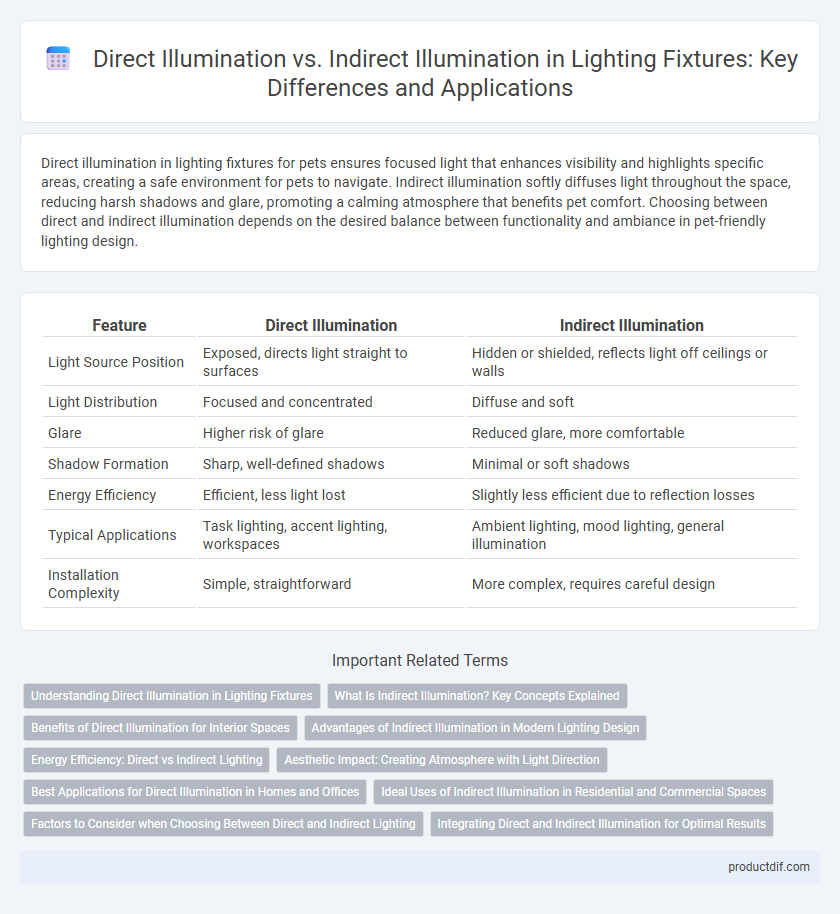Direct illumination in lighting fixtures for pets ensures focused light that enhances visibility and highlights specific areas, creating a safe environment for pets to navigate. Indirect illumination softly diffuses light throughout the space, reducing harsh shadows and glare, promoting a calming atmosphere that benefits pet comfort. Choosing between direct and indirect illumination depends on the desired balance between functionality and ambiance in pet-friendly lighting design.
Table of Comparison
| Feature | Direct Illumination | Indirect Illumination |
|---|---|---|
| Light Source Position | Exposed, directs light straight to surfaces | Hidden or shielded, reflects light off ceilings or walls |
| Light Distribution | Focused and concentrated | Diffuse and soft |
| Glare | Higher risk of glare | Reduced glare, more comfortable |
| Shadow Formation | Sharp, well-defined shadows | Minimal or soft shadows |
| Energy Efficiency | Efficient, less light lost | Slightly less efficient due to reflection losses |
| Typical Applications | Task lighting, accent lighting, workspaces | Ambient lighting, mood lighting, general illumination |
| Installation Complexity | Simple, straightforward | More complex, requires careful design |
Understanding Direct Illumination in Lighting Fixtures
Direct illumination in lighting fixtures delivers light straight from the source to the target area, ensuring high intensity and sharp shadow definition. This method maximizes luminous efficacy, making it ideal for task lighting and accentuating architectural features. Fixtures such as spotlights, downlights, and pendants commonly employ direct illumination to provide focused brightness where it is most needed.
What Is Indirect Illumination? Key Concepts Explained
Indirect illumination refers to lighting that is diffused by reflecting off surfaces such as ceilings, walls, or floors, creating a softer and more evenly distributed light. This technique minimizes glare and harsh shadows by using bounced light rather than direct beams from the fixture. Common applications include cove lighting and wall washing, enhancing ambiance and visual comfort in residential and commercial spaces.
Benefits of Direct Illumination for Interior Spaces
Direct illumination enhances interior spaces by providing focused, bright light that improves visibility and task performance. It maximizes energy efficiency by minimizing light loss and creating sharp contrasts, which can highlight architectural features and decor elements. This lighting method reduces eye strain, making it ideal for workspaces, kitchens, and reading areas where precision is critical.
Advantages of Indirect Illumination in Modern Lighting Design
Indirect illumination in modern lighting design offers enhanced visual comfort by reducing glare and harsh shadows, creating a softer, more uniform light distribution. It promotes energy efficiency by maximizing the use of reflected light, which can illuminate larger areas with fewer fixtures. This approach also enhances aesthetic appeal, highlighting architectural features while maintaining a cozy and inviting atmosphere.
Energy Efficiency: Direct vs Indirect Lighting
Direct illumination delivers light straight to the target area, maximizing energy efficiency by reducing light loss and minimizing wasted lumens. Indirect illumination bounces light off surfaces, creating softer ambiance but often requiring higher wattage to maintain brightness levels. Choosing direct lighting fixtures can significantly lower electricity consumption while providing focused task lighting essential for productivity.
Aesthetic Impact: Creating Atmosphere with Light Direction
Direct illumination enhances the aesthetic impact by casting focused beams that highlight architectural features and create sharp contrasts, emphasizing texture and form. Indirect illumination softens the atmosphere through diffused light reflected off surfaces, generating a warm, inviting ambiance with minimal shadows. Balancing direct and indirect lighting allows designers to manipulate spatial perception and mood, contributing significantly to the overall visual experience.
Best Applications for Direct Illumination in Homes and Offices
Direct illumination delivers focused, high-intensity light ideal for task-oriented areas such as kitchen countertops, reading nooks, and office workstations. It enhances visibility by minimizing shadows and glare, making it perfect for detailed activities like cooking, writing, or computer work. In residential and commercial spaces, direct lighting fixtures such as pendant lamps, track lights, and desk lamps optimize productivity and precision.
Ideal Uses of Indirect Illumination in Residential and Commercial Spaces
Indirect illumination enhances ambiance by softly diffusing light through ceilings or walls, minimizing glare and creating a comfortable environment ideal for living rooms, bedrooms, and relaxation areas in residential spaces. In commercial settings, this lighting technique improves visual comfort and focus in offices, retail stores, and hospitality venues by reducing harsh shadows and evenly distributing light. The strategic use of indirect illumination supports both aesthetic appeal and functional lighting needs where a calm, inviting atmosphere is prioritized.
Factors to Consider when Choosing Between Direct and Indirect Lighting
Choosing between direct and indirect lighting involves evaluating factors such as desired brightness levels, room function, and ambiance. Direct illumination provides focused light ideal for tasks, while indirect lighting offers softer, diffused illumination that enhances overall mood and reduces glare. Consider energy efficiency, fixture placement, and ceiling height to achieve optimal lighting design tailored to specific spatial needs.
Integrating Direct and Indirect Illumination for Optimal Results
Integrating direct and indirect illumination in lighting fixtures enhances spatial perception and visual comfort by balancing brightness and reducing glare. Combining direct light sources for task efficiency with indirect lighting that softens shadows creates an adaptable environment suitable for various activities. Utilizing dimmable LED technology and strategically placed reflectors further optimizes light distribution, energy efficiency, and ambiance control.
Direct illumination vs indirect illumination Infographic

 productdif.com
productdif.com